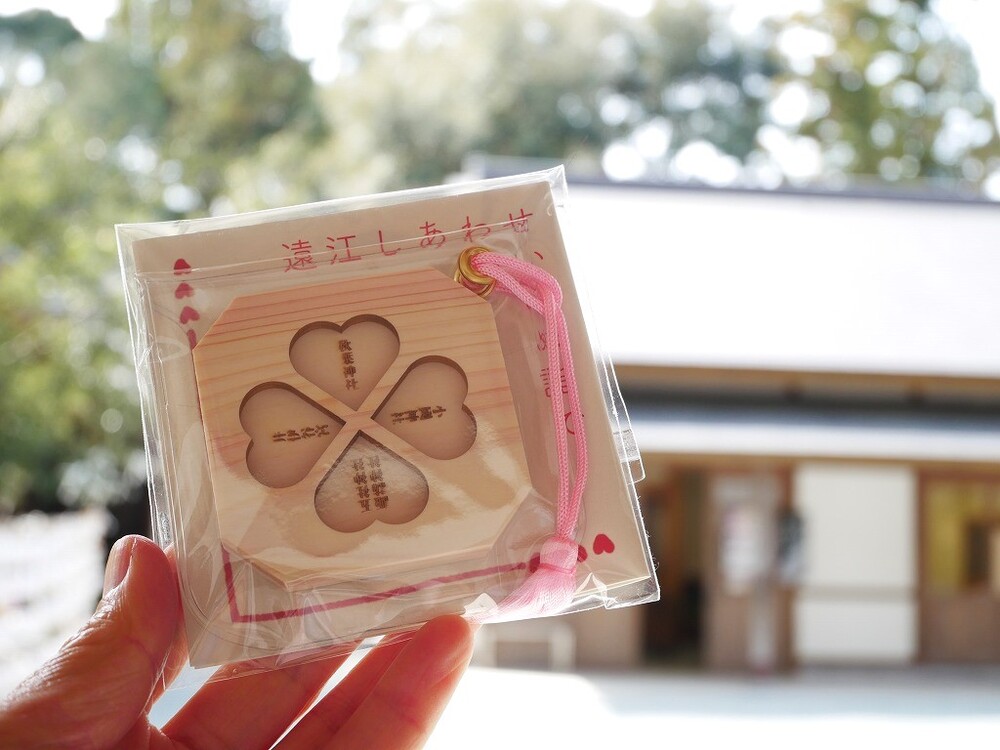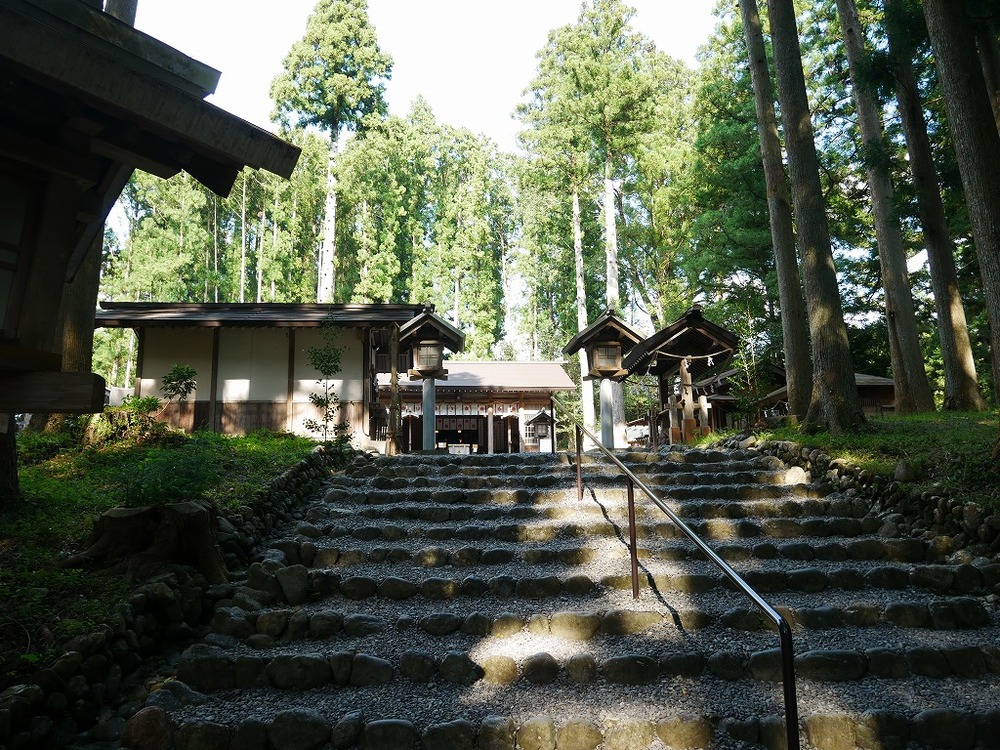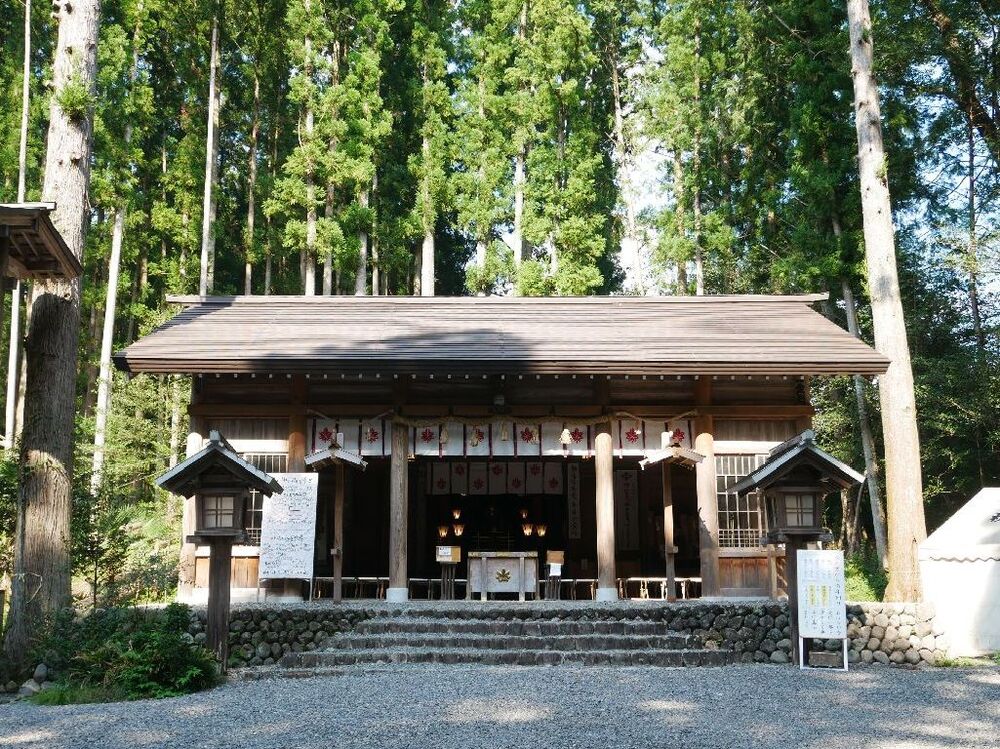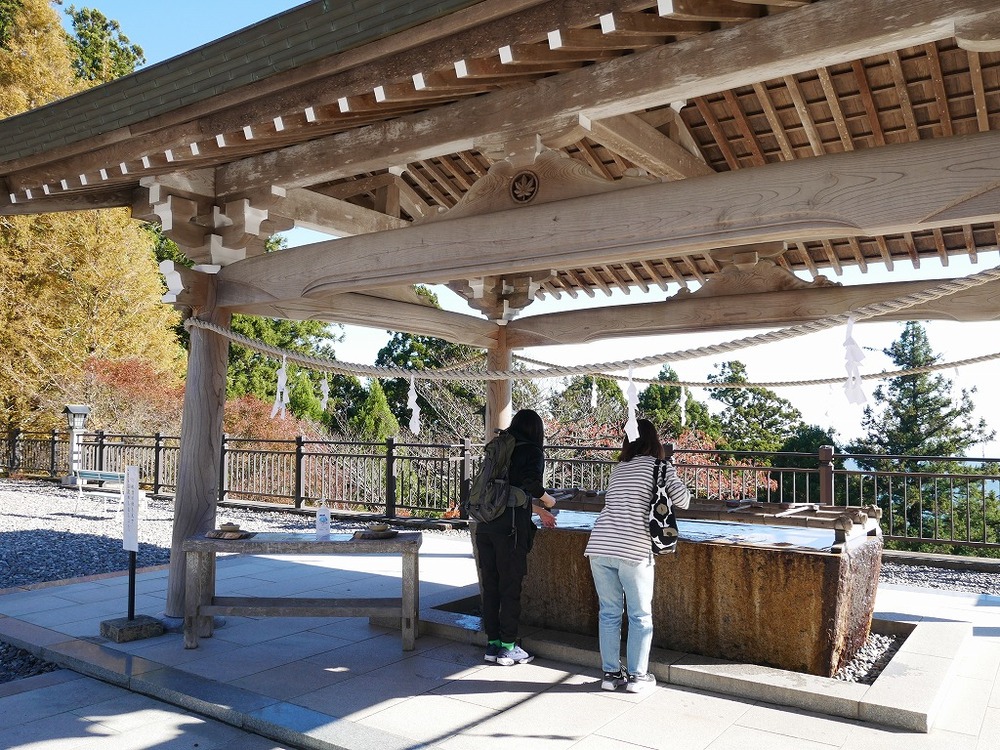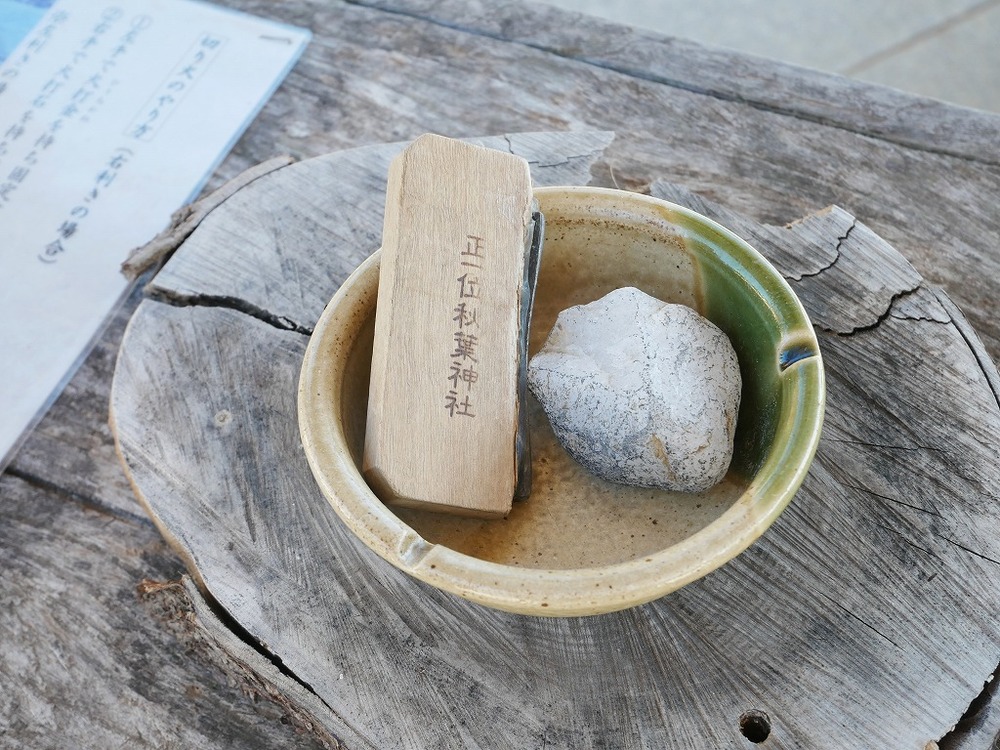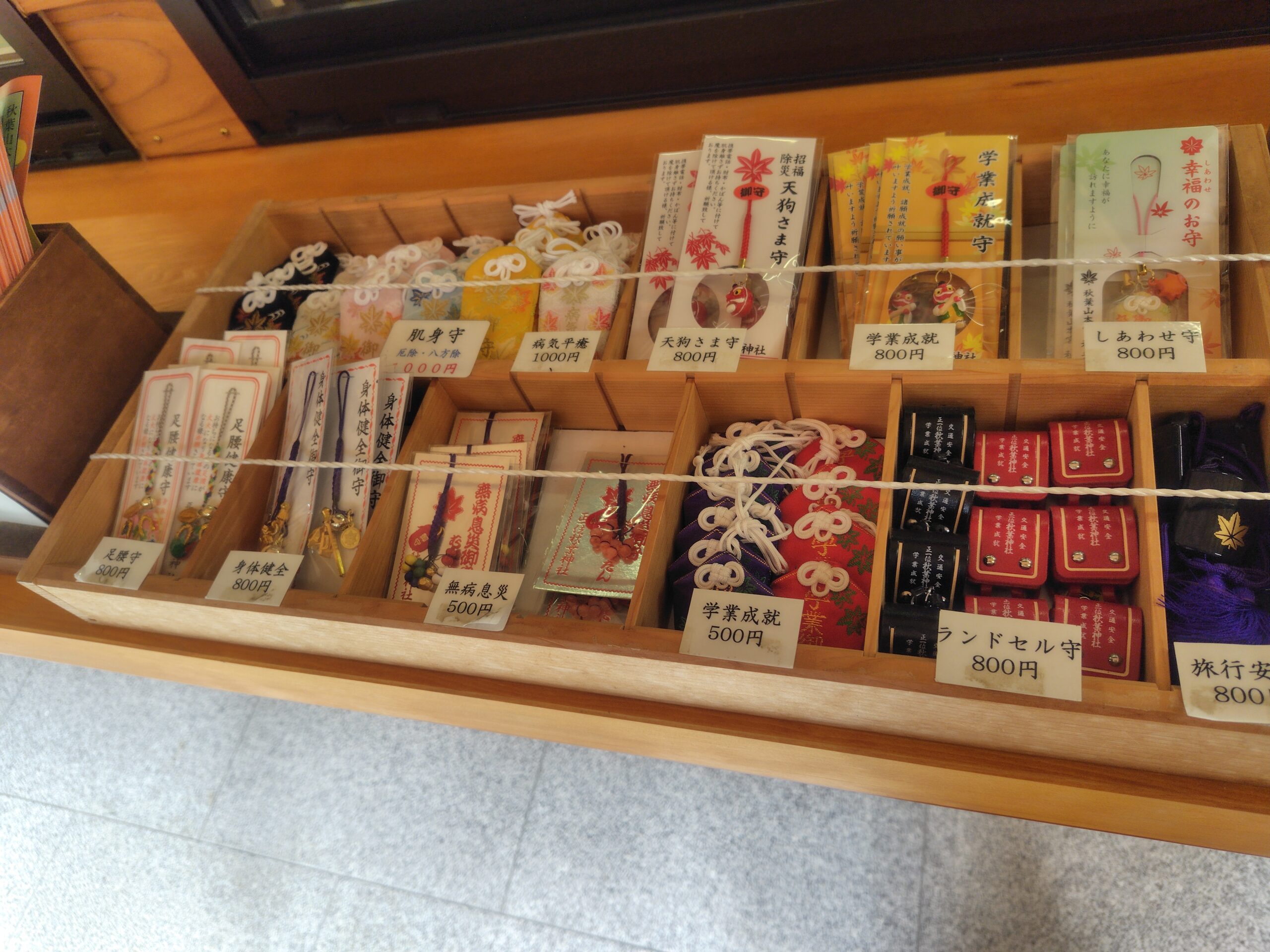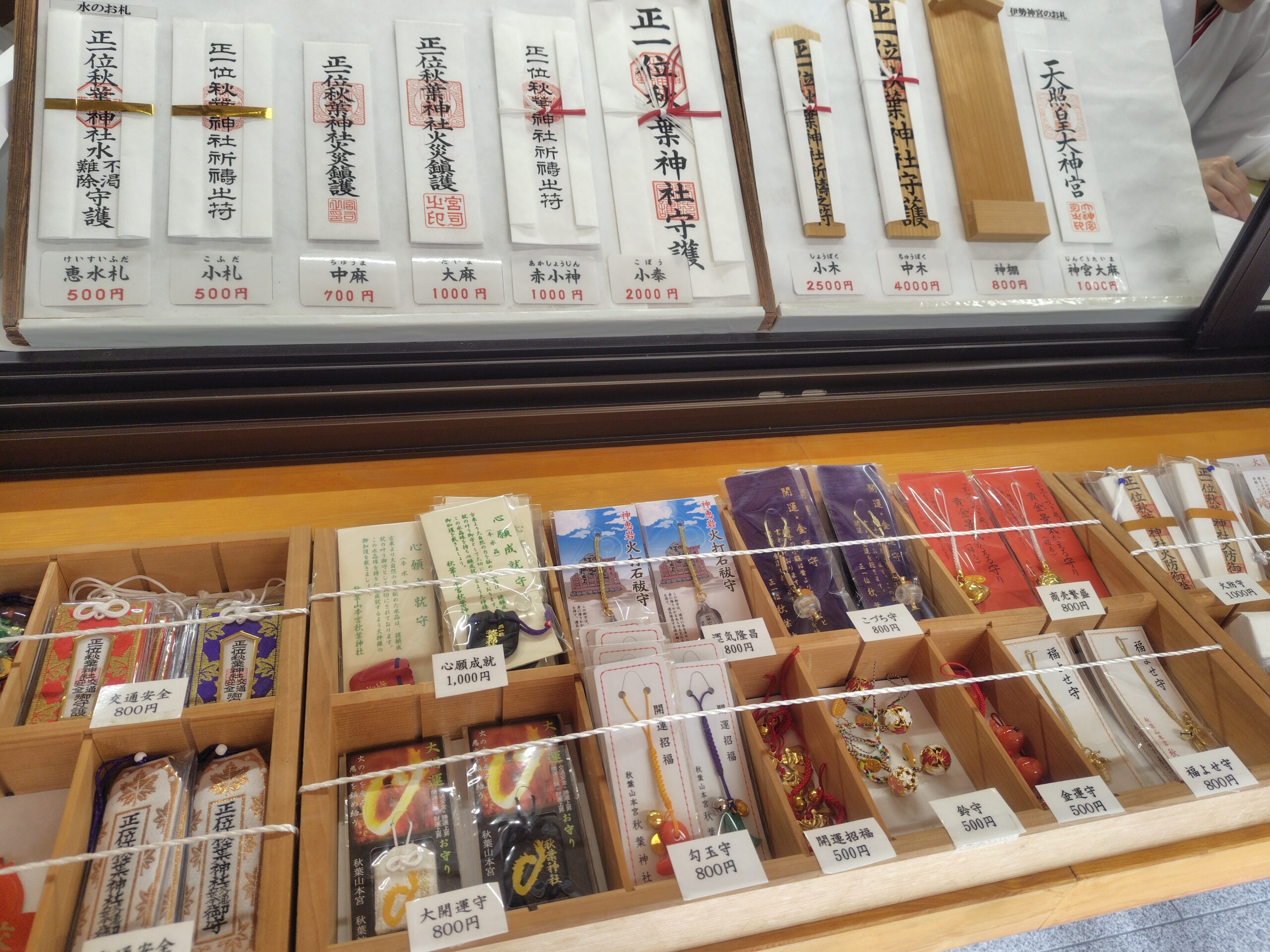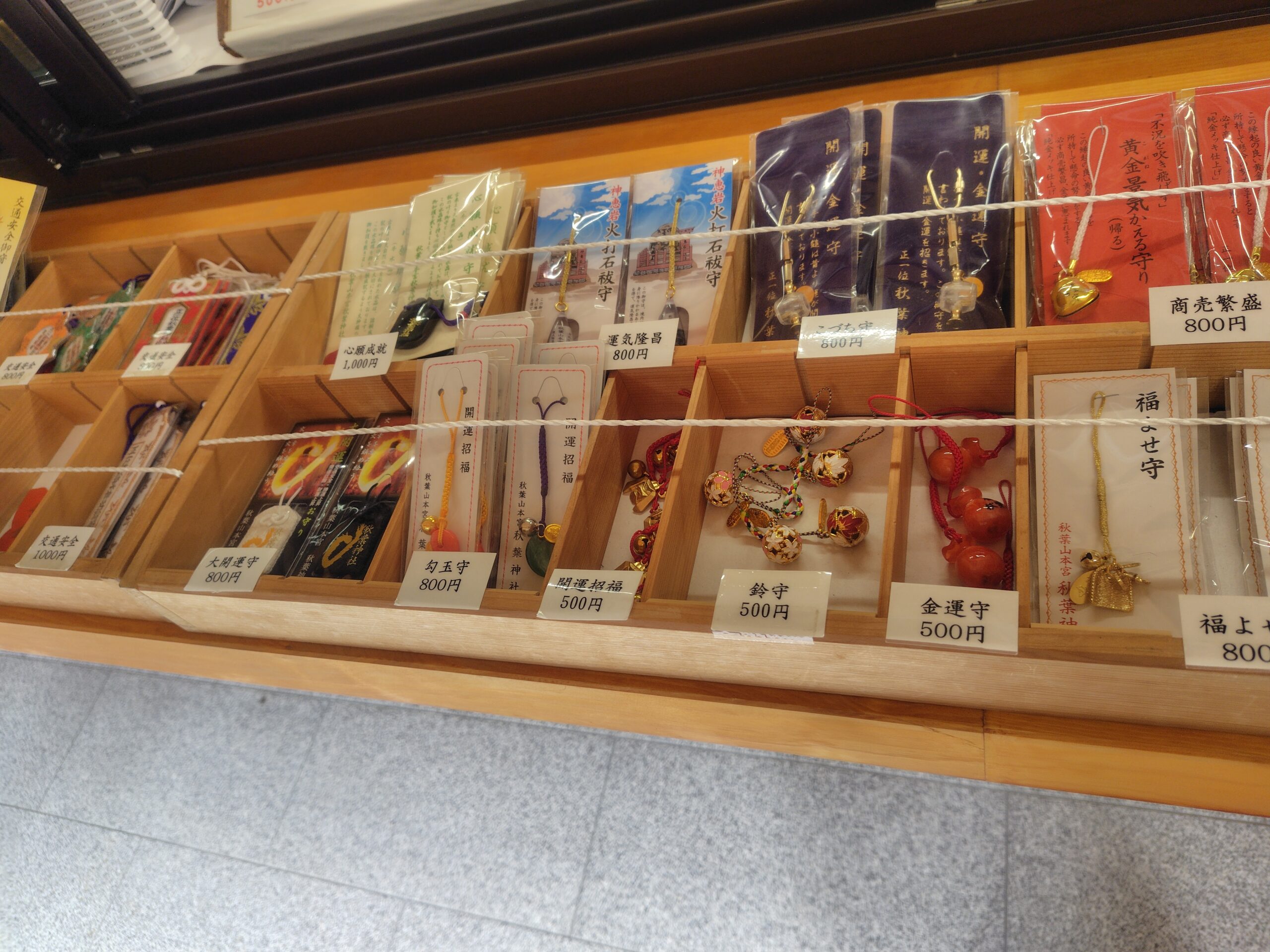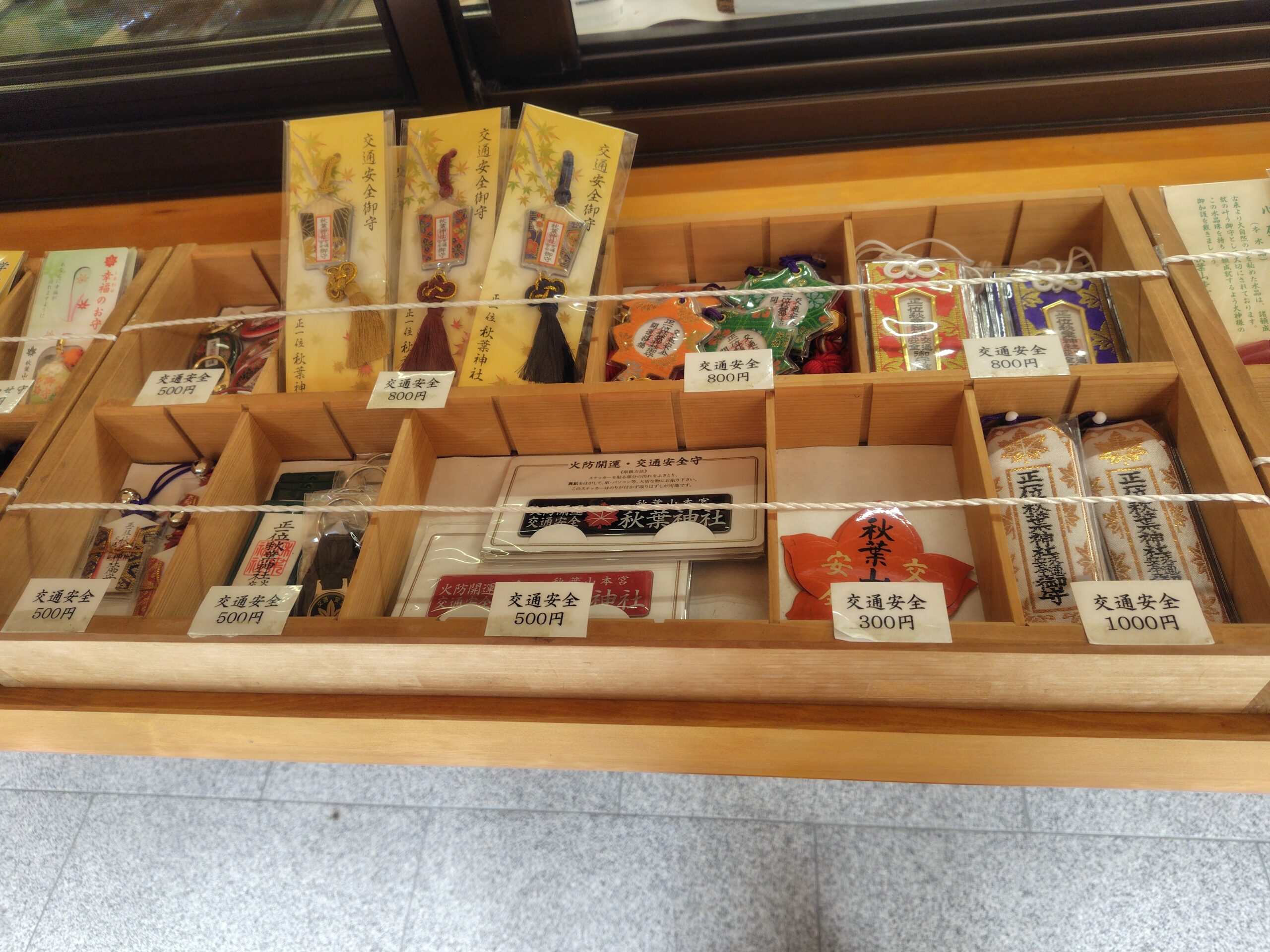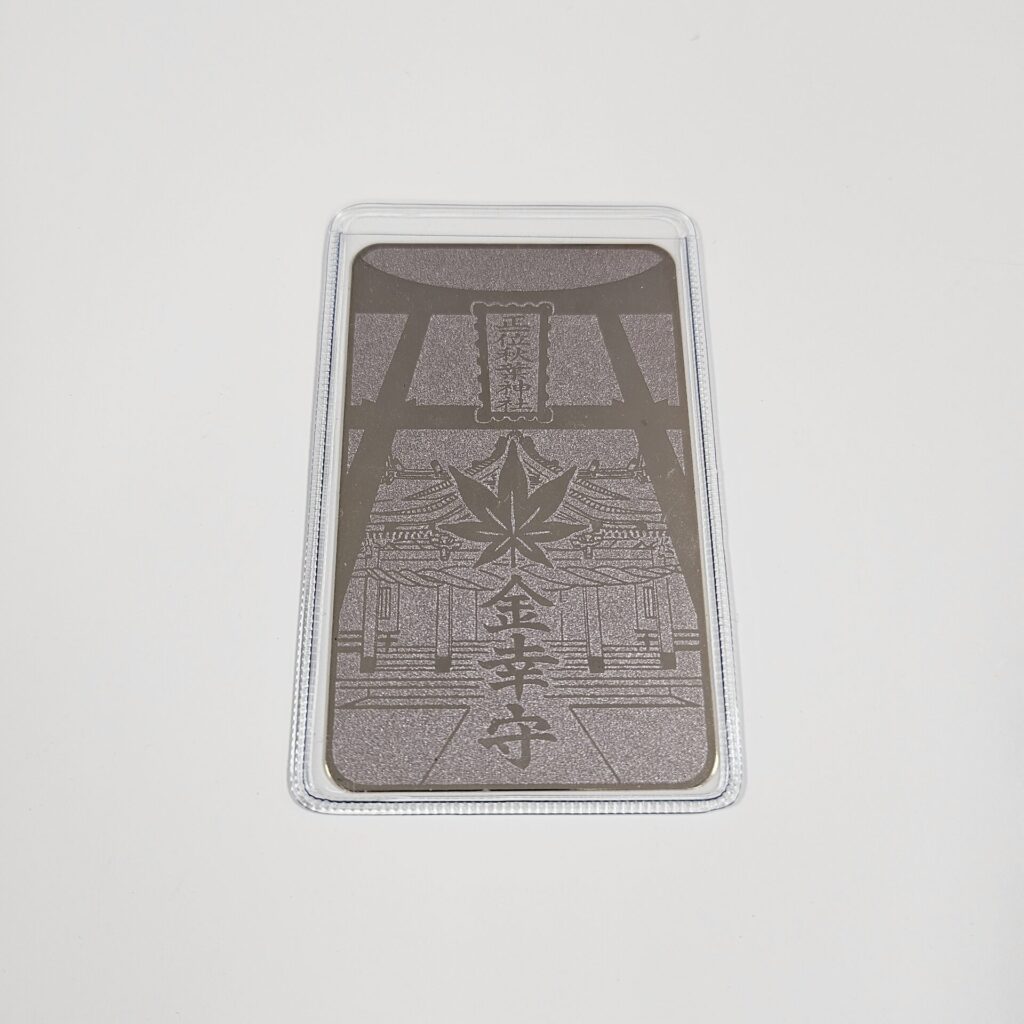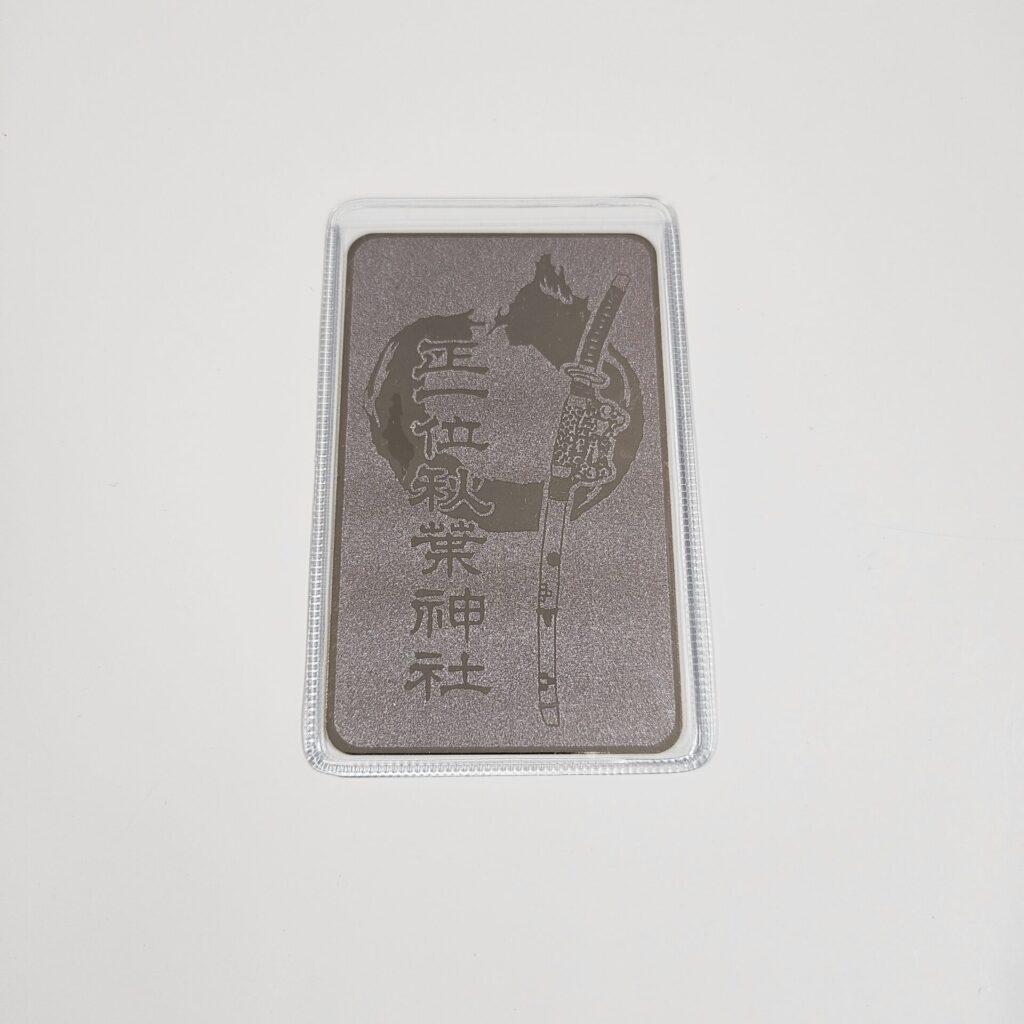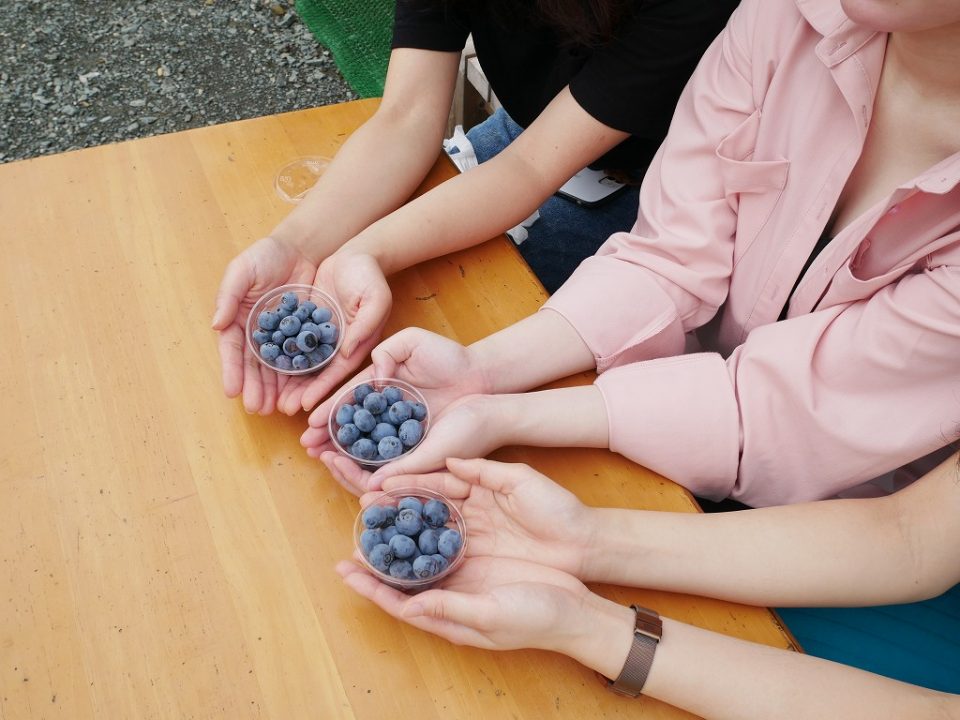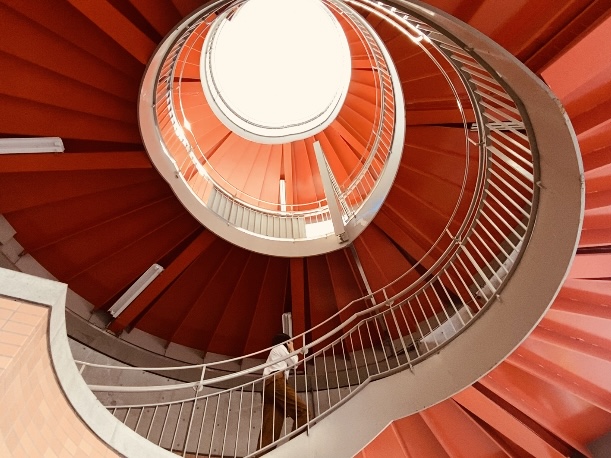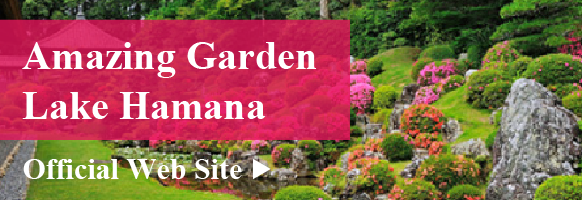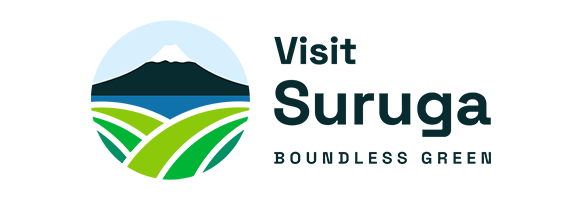Get to Know Hamamatsu
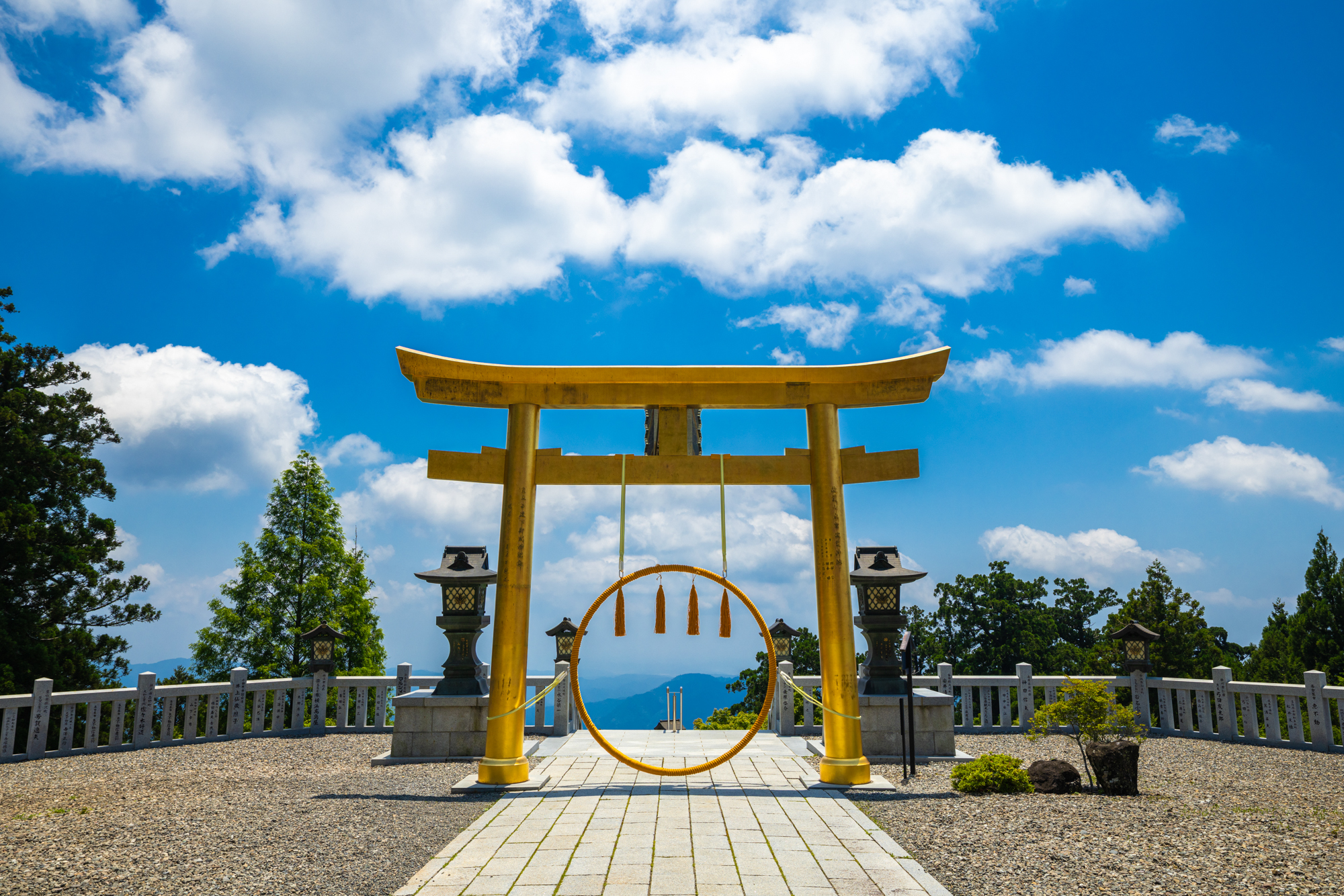
- Watch
Akiha Shrine: A Hidden Sanctuary of Nature and Faith in Hamamatsu
Akiha Shrine has two sites: the Upper Shrine atop Mt. Akiha and the Lower Shrine at its base. The “Torii of Happiness” at the summit is a must-visit spot…
Nestled in the Tenryu district of Hamamatsu City, Akihasan Hongu Akiha Shrine—commonly known as Akiha Shrine—is the head shrine of all Akiha shrines found throughout Japan.
Dedicated to the god of fire protection, Akiha Shrine is made up of two main sites: the Upper Shrine at the summit of Mount Akiha, and the Lower Shrine at its base.
The shrine has a long history, dating back to the year 709.
Hinokagutsuchi-no-Ōmikami, the fire god enshrined here, is the son of Izanagi and Izanami—the deities who, according to legend, gave birth to the land and gods of Japan.
This time, we’ll introduce Akihasan Hongu Akiha Shrine by focusing on its two main sites: the Lower Shrine and the Upper Shrine.
Lower Shrine
About 40 kilometers north-northeast of JR Hamamatsu Station, the Lower Shrine of Akiha is located at the base of Mount Akiha.
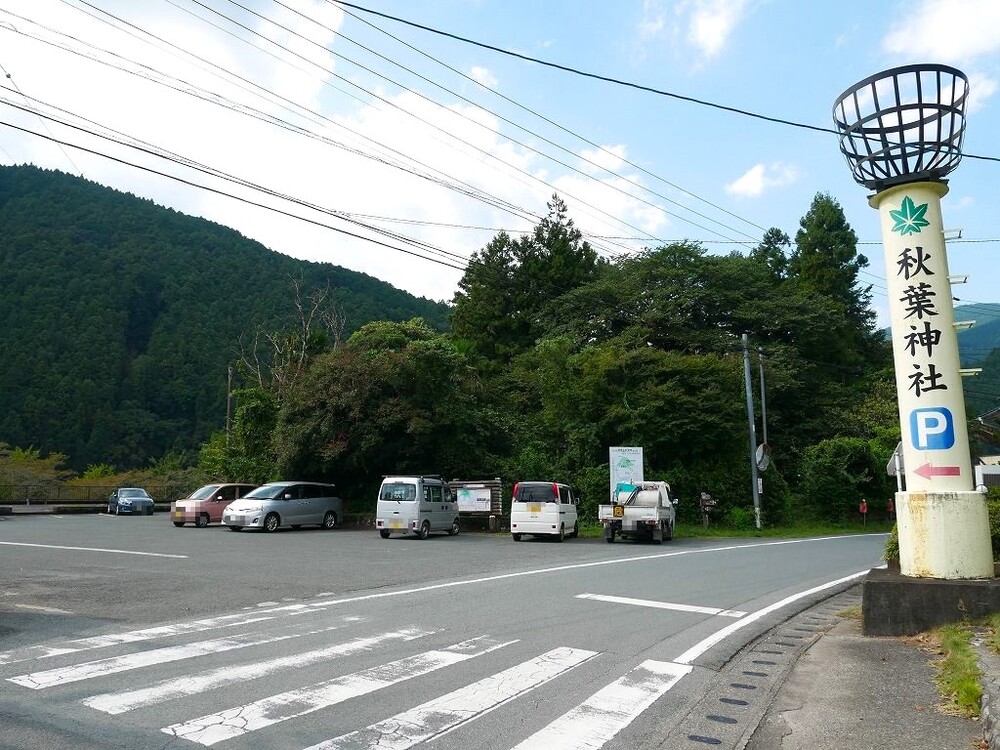
Parking at Akiha Shrine Lower Shrine
The parking lot is located just across the road from the shrine.
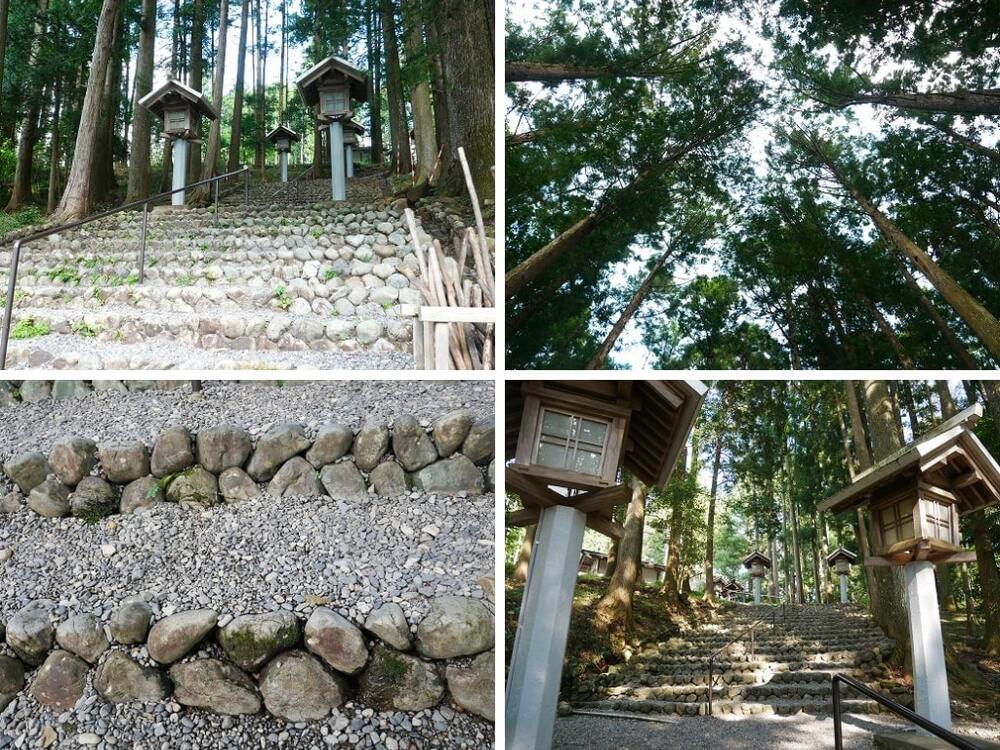
Top left: Entrance to the approach path, Top right: Tall cedar trees tower above, Bottom left: Stone steps made from natural rocks and gravel, Bottom right: The path is lined with traditional Japanese lanterns lanterns on both sides
From a small arched bridge, you begin climbing a stone staircase that leads up to it.
Looking up, you see towering cedar trees that mark the sacred grounds.
Looking down, your eyes follow the clear flow of the Keta River below.
The stone steps, made from natural rocks and gravel, feel like they fill you with the energy of nature just by climbing them.
At the top of the stone steps stands the Lower Shrine’s worship hall, right in front of you.
The offering box and the sacred curtain both feature Akihasan Shrine’s emblem—the “Seven-Leaf Maple.”
You’ll spot this symbol throughout the shrine grounds.
The Lower Shrine’s Formal Name is Yōsaiden — Purification with Kiribi!
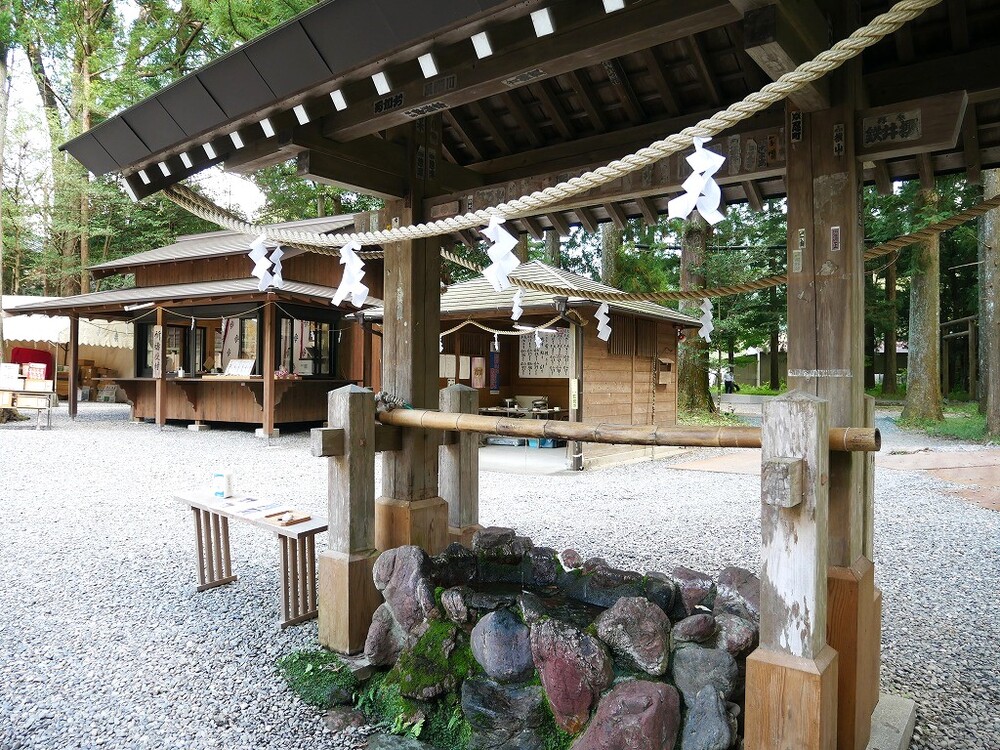
Before entering the shrine, take a moment to purify yourself at the purification fountain.
At Akihasan Shrine, which enshrines the god of fire protection, visitors can purify themselves not only at the traditional purification fountain, but also through a unique ritual using flint and steel, performed beside it.
This ritual, known as kiribi, involves striking flint to produce sparks—a traditional method used to purify oneself and ward off evil.
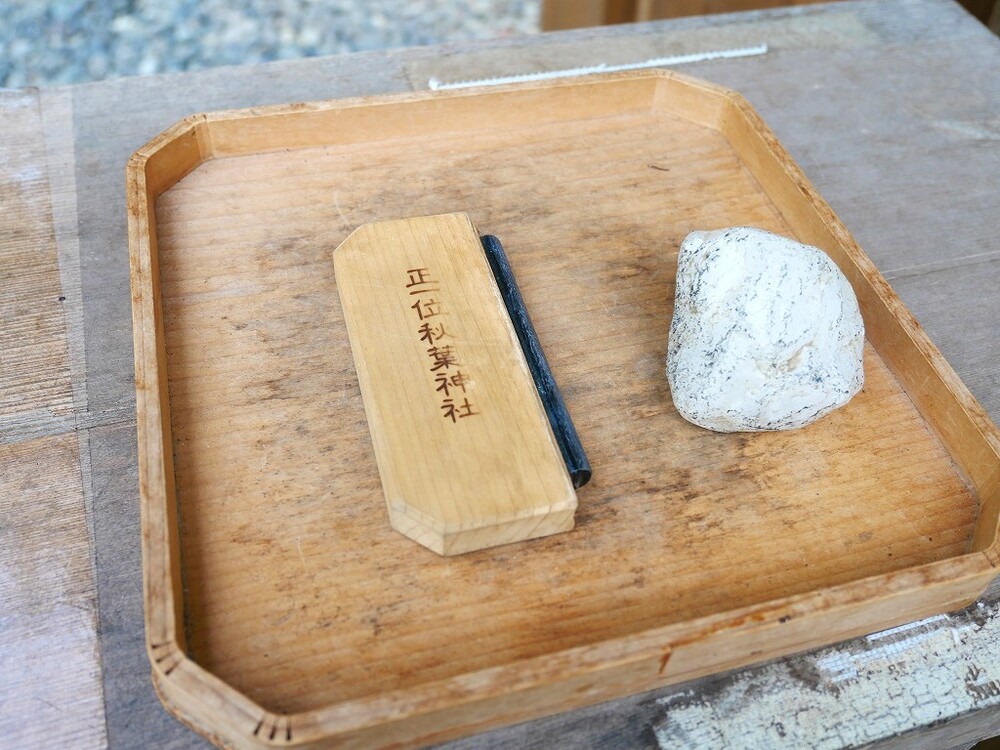
This purification ritual using kiribi was introduced after the traditional purification fountain became unavailable during the COVID-19 pandemic.
It’s a unique practice that truly reflects Akiha Shrine’s dedication to the god of fire protection.
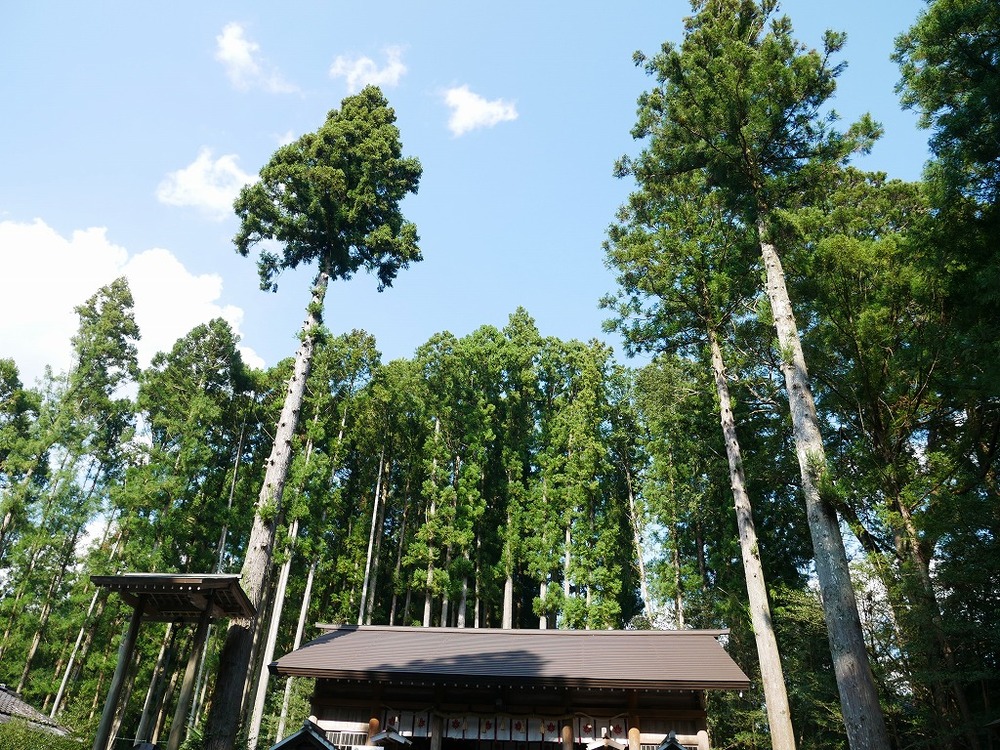
Looking up at the sky just before the worship hall… Could the main hall of the Upper Shrine be right behind?
Built in 1943, Akiha Lower Shrine’s formal name is Yōsaiden.
It is a shrine dedicated to worshipping the main hall of the Upper Shrine, which sits atop Mount Akiba, from a distance.
So, just beyond the front of the worship hall, could the main hall of the Upper Shrine be far in the distance?
Curious about this, I asked Mr. Kitō, the chief priest’s assistant, who explained:
“The main hall of the Upper Shrine isn’t directly behind the Lower Shrine’s worship hall, but rather about 30 degrees to the left diagonal.
It’s in the direction beyond the giant jūnō—a tool used for carrying burning charcoal—that’s dedicated to the left side of the worship hall.”
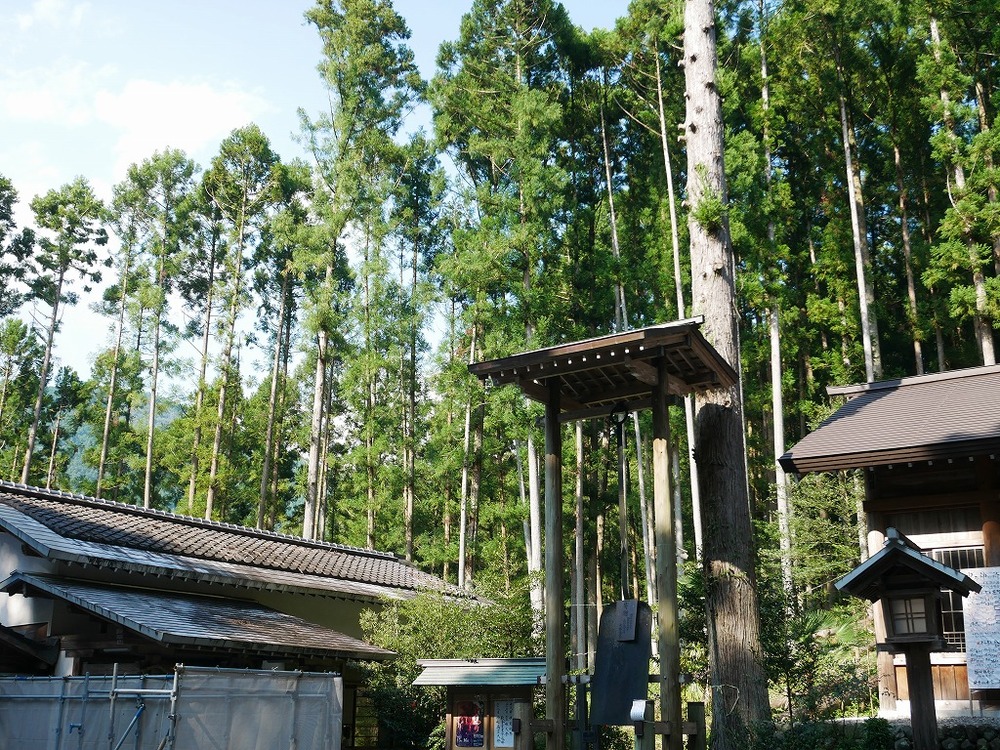
From the Lower Shrine’s worship hall, look about 30 degrees to the left diagonal—the giant tool that looks like a huge shovel just slightly right of center in the photo is the jūnō.
The pilgrimage path from the Lower Shrine to the Upper Shrine is for pedestrians only
Akiha Shrine has a main pilgrimage path for pedestrians only that connects the Upper Shrine and the Lower Shrine.
The elevation difference between Akiha Shrine’s Upper and Lower Shrines is about 750 meters, with a distance of over 4 kilometers.
It takes about 1.5 to 2 hours to walk one way at an average adult’s pace.
Since the path has a lot of elevation changes and winds through deep mountain forests, please be mindful of your physical condition and gear.
Upper Shrine
The golden torii gate of Akiha-san Sōhongu Akiha Shrine’s Upper Shrine shines brightly.
Located about 50 kilometers north-northeast of JR Hamamatsu Station, it sits atop Mount Akiha, at an elevation of 866 meters, in Haruno Town, Tenryu Ward.
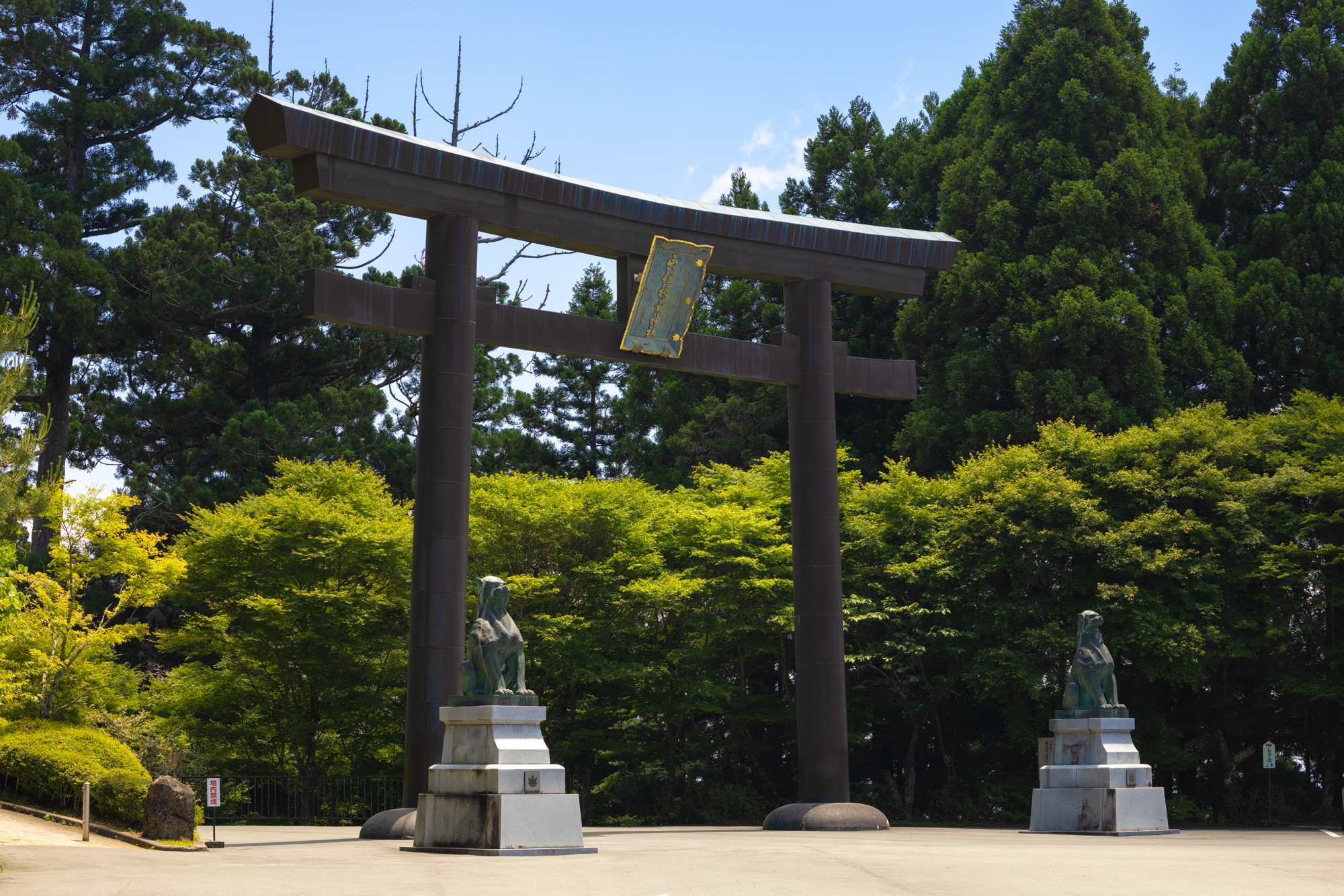
There are two main ways to access Akiha Shrine’s Upper Shrine: on foot or by car.
As mentioned earlier, if you choose to walk, the path covers over 4 kilometers with an elevation difference of about 750 meters.
Since the trail winds through dense mountain forests, please be mindful of your physical condition and gear.
If you’re coming by car, you can park in the lot near the shrine building.
From there, you’ll need to walk up the stone steps to reach the shrine.

Along both sides of the approach path from the great torii gate to the main hall, stone lanterns engraved with Akiha Shrine’s emblem—the seven-leaf maple—stand in a row.
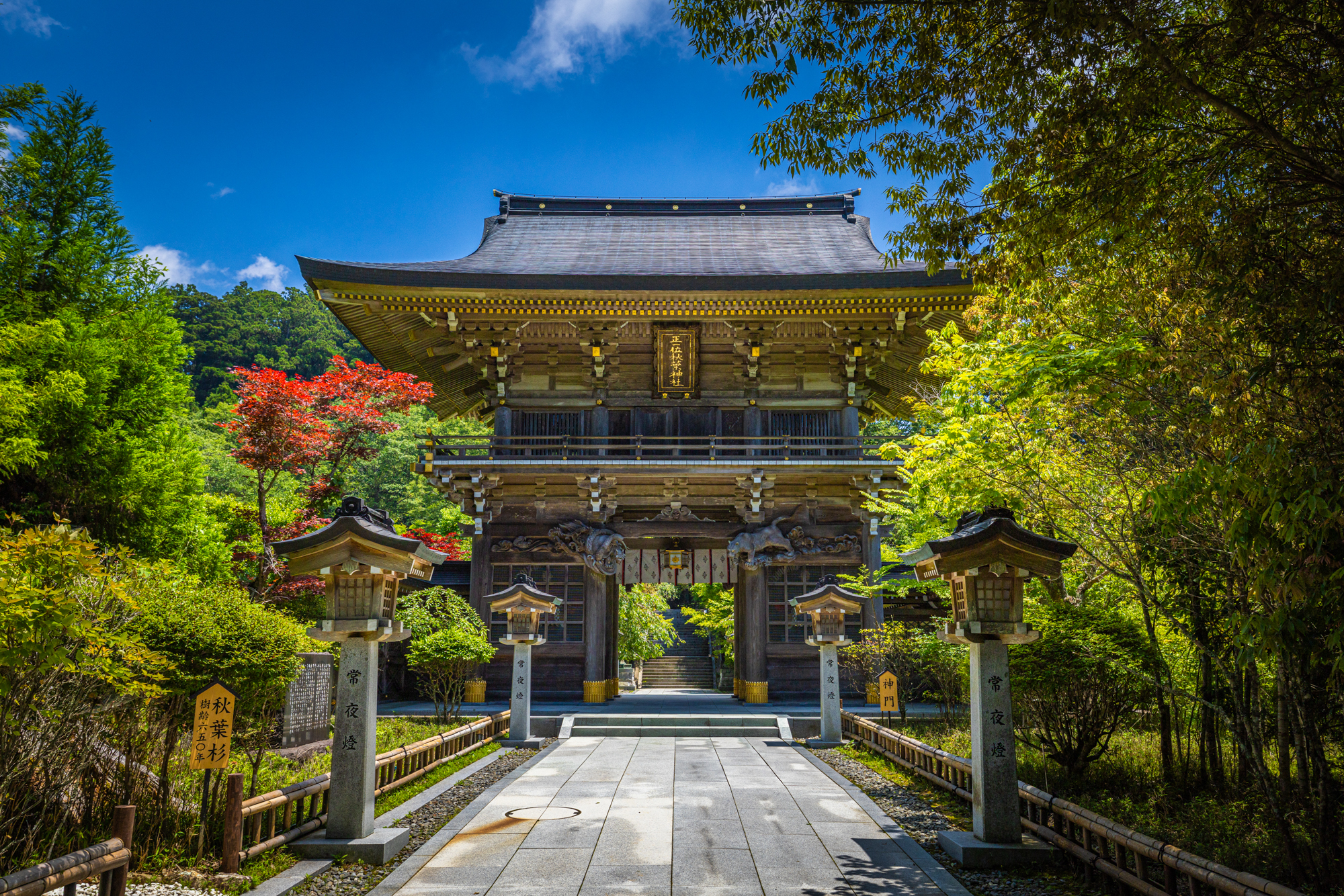
Just before the main hall, there are two shrine gates—one on the east side and one on the west side of the approach path.
The western gate, called Nishi-no-Kadomori no Shinmon, is about a ten- to fifteen-minute walk from the parking lot at a relaxed pace.
The word Kadomori refers to a gatekeeper.
At Akiha Shrine, it symbolizes the role of guiding and connecting visitors to the deity enshrined here.
At each corner of the gate, you’ll find the Four Divine Beasts—Seiryū (Azure Dragon), Suzaku (Vermilion Bird), Genbu (Black Tortoise), and Byakko (White Tiger).
Take a closer look at their gleaming eyes—their sharp gazes are hard to miss!
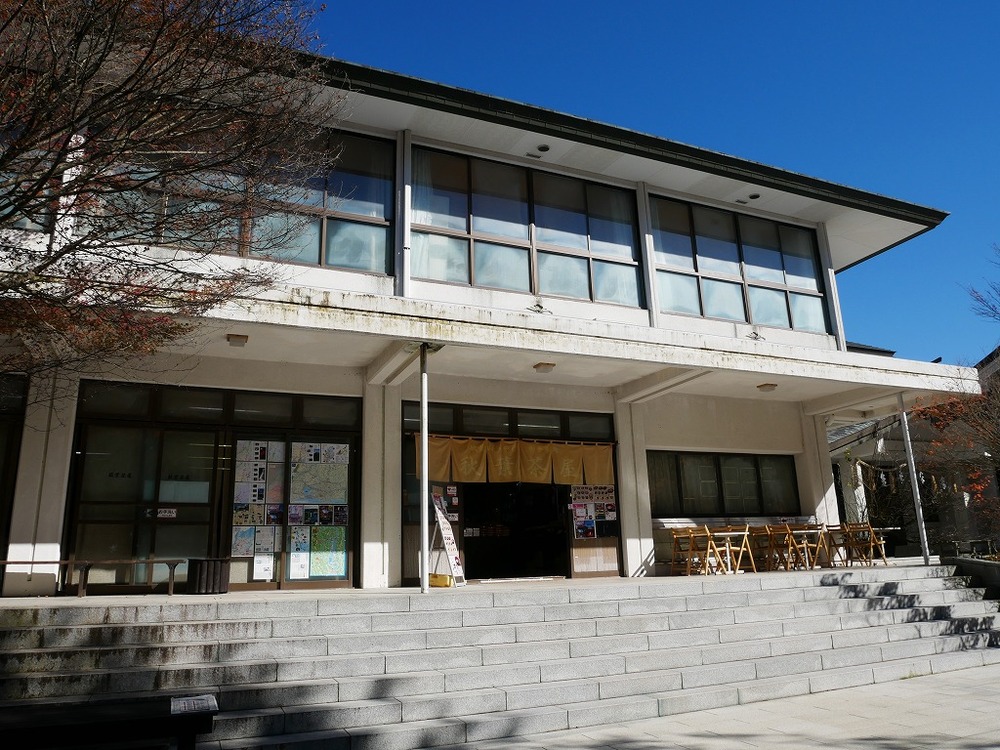
Akiha Chaya
If you’re looking for a place to rest before or after your visit, stop by Akiha Chaya.
You can enjoy a meal or a relaxing tea break, and browse a selection of local souvenirs from Mount Akiha inside the shop.
From here, it’s just a little farther to the main shrine building.
You can try the kiribi purification ritual and the tengu plate-throwing activity in front of the shrine office
Before approaching the main hall, stop by the purification fountain to cleanse yourself.
Just like at the Lower Shrine, you can also perform the kiribi fire-cleansing ritual here at the Upper Shrine.
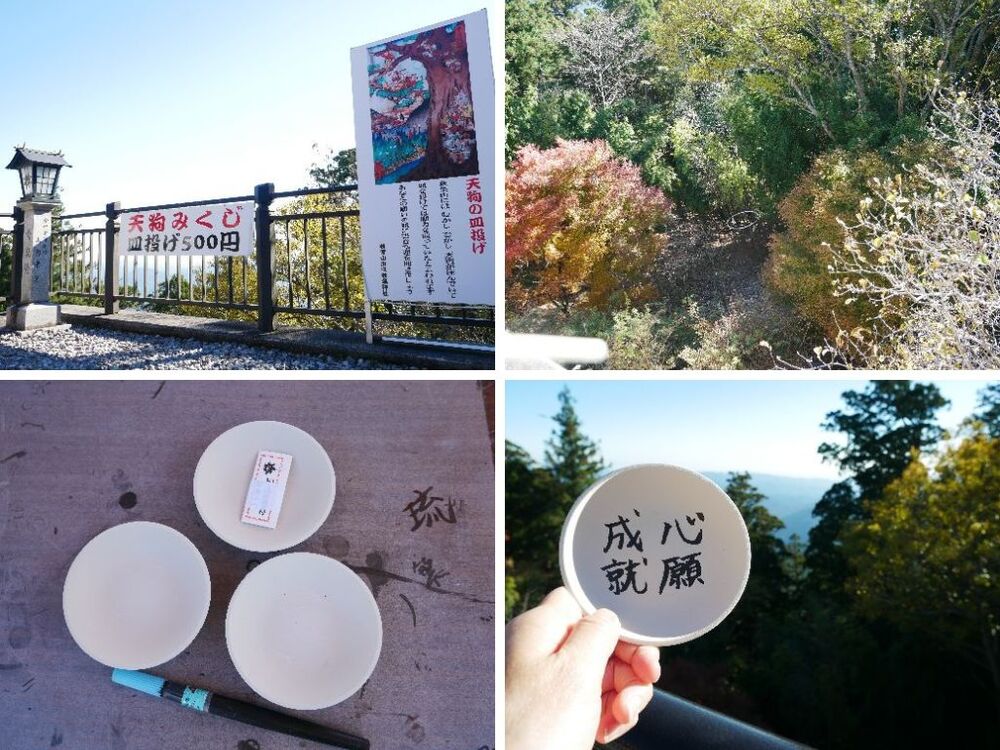
Top left: This is where the tengu plate-throwing takes place, Top right: Aim to throw the plate right through the white ring in the center, Bottom left: A small plate and an omikuji (fortune slip), Bottom right: The author gives it a try!
A popular activity when visiting the Akiha Shrine Upper Shrine is the “Tengu Plate-Throwing,” located near the purification fountain.
Write your wish on a small plate , then toss it toward the ring set below the cliff.
If your plate passes through the ring, your wish is said to come true.
If you’re curious, why not give it a try?
Step through the shimmering golden Torii Gate of Heaven — the “Torii of Happiness” — and begin your sacred visit!

The golden, shimmering Torii of Happiness (The golden ring installed on the golden torii is called a Chinowa (ring of miscanthus), and it is not always in place. Please check the installation period in advance.)
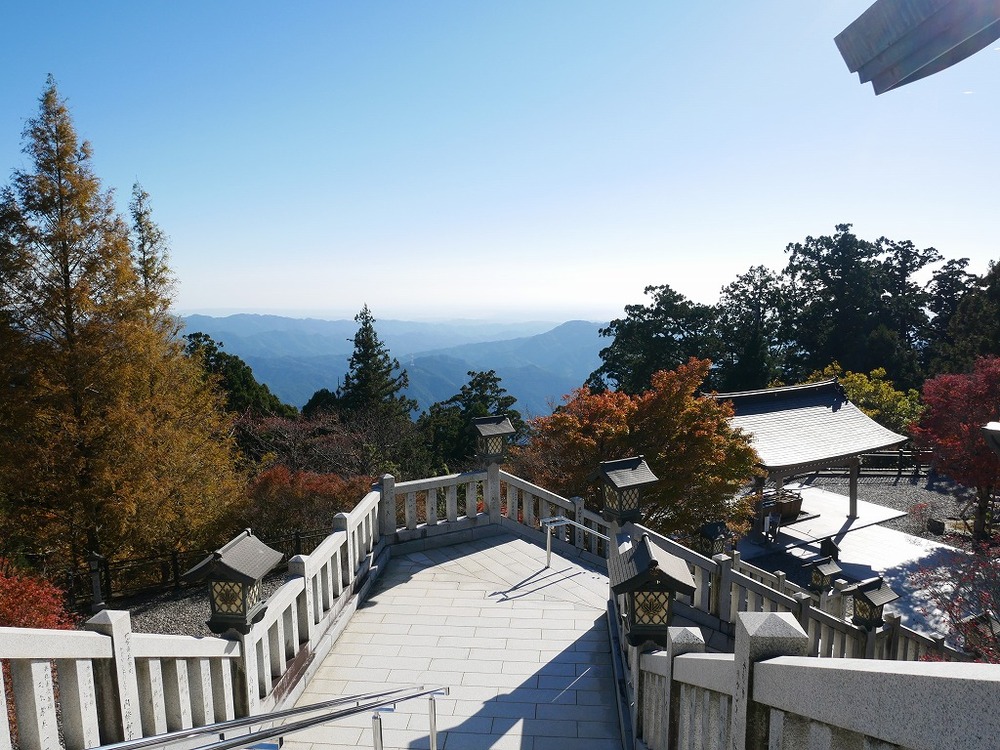
Looking out from the Torii of Happiness at the view below
The golden Torii, so radiant it feels like just seeing it could bring you happiness, stands at the top of the stairs between the shrine office and the purification fountain.
It was named the “Torii of Happiness” because it was built with the hope of bringing happiness to all who visit.
The golden torii stands out beautifully against the blue sky — both elegant and majestic.
Below, the deep green mountains of Tenryū stretch out as far as the eye can see.
It’s easy to see why this golden torii is known as the “Golden Torii in the Sky.”
Passing through the torii, you’ll find the sacred Shinkeigan straight ahead, the Ofudasyo to the left, and the Kaguraden to the right.
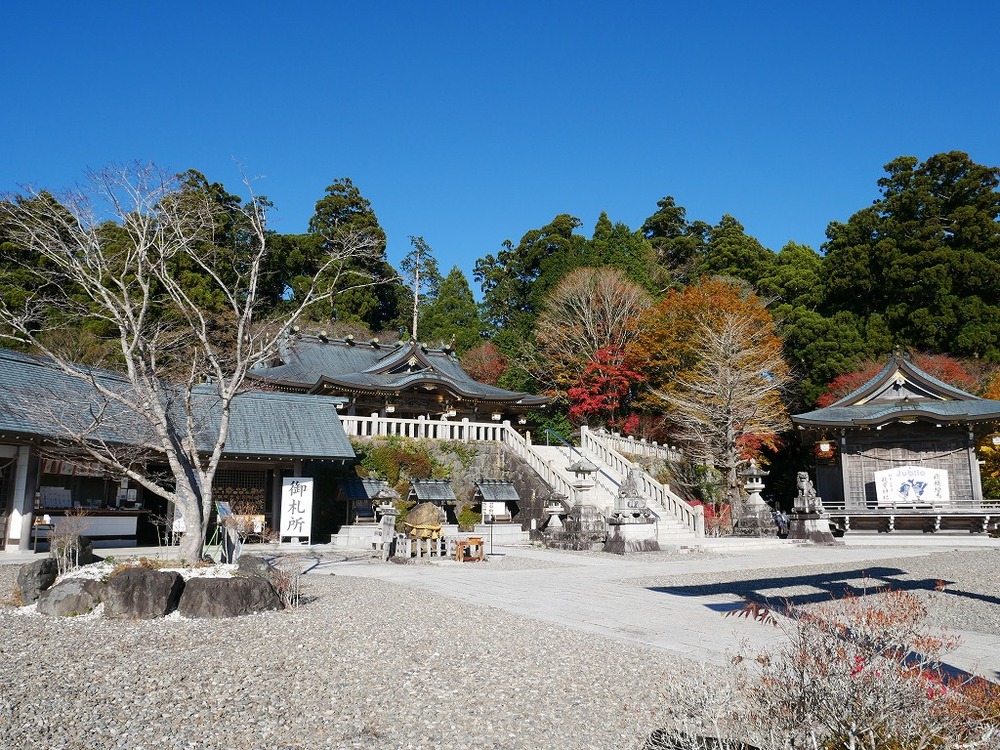
The stairs leading to the main hall can be found between Shinkeigan and the Kaguraden.
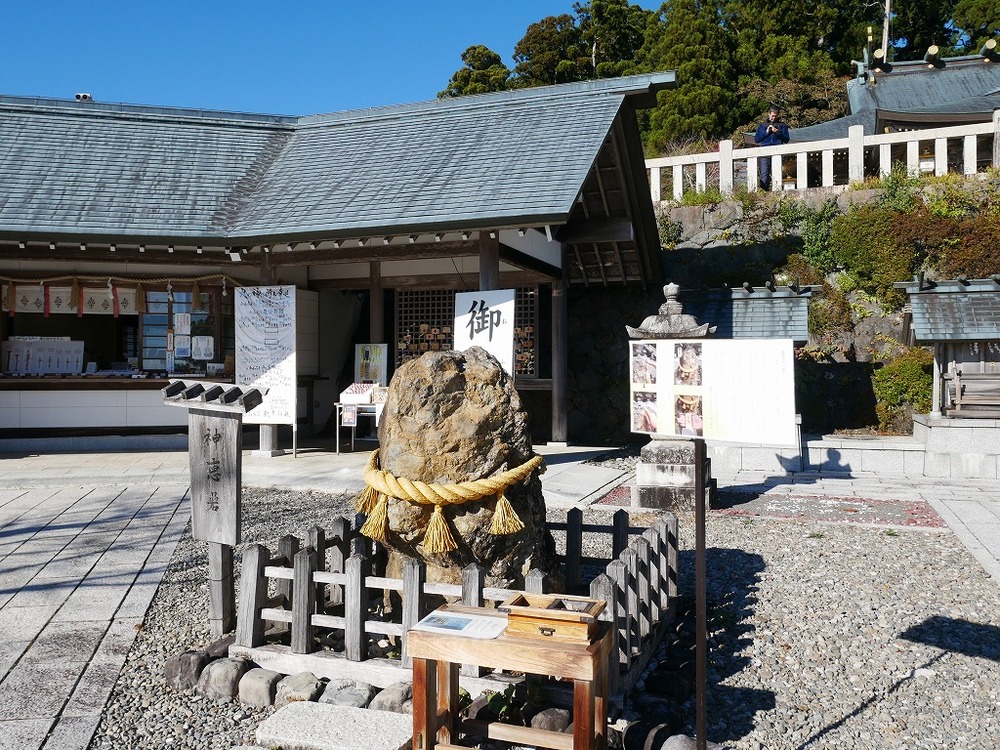
Shinkeigan
Shinkeigan is a massive hiuchi-ishi — a natural fire-striking stone — that was offered to the shrine after being unearthed from the mountains of the Akihasan range.
That’s right — this entire rock is a firestone!
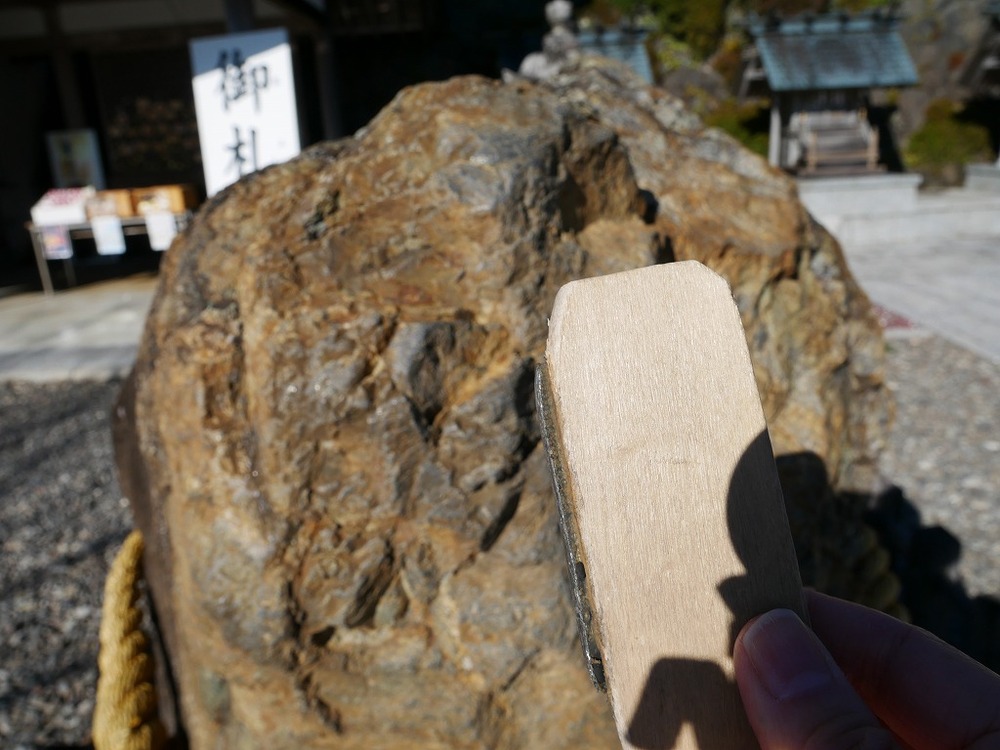
The Kiribi purification here is almost the same as at the hand-washing pavilion.
When you hold the hiuchigane (fire striker), strike it lightly 2 or 3 times so sparks fly out.
Try performing Kiribi on the Shinkeigan stone to cleanse yourself, ward off bad luck, and pray for your greatest wishes to come true!
Pray for fire protection at the Main Hall, perched atop Mount Akiha.
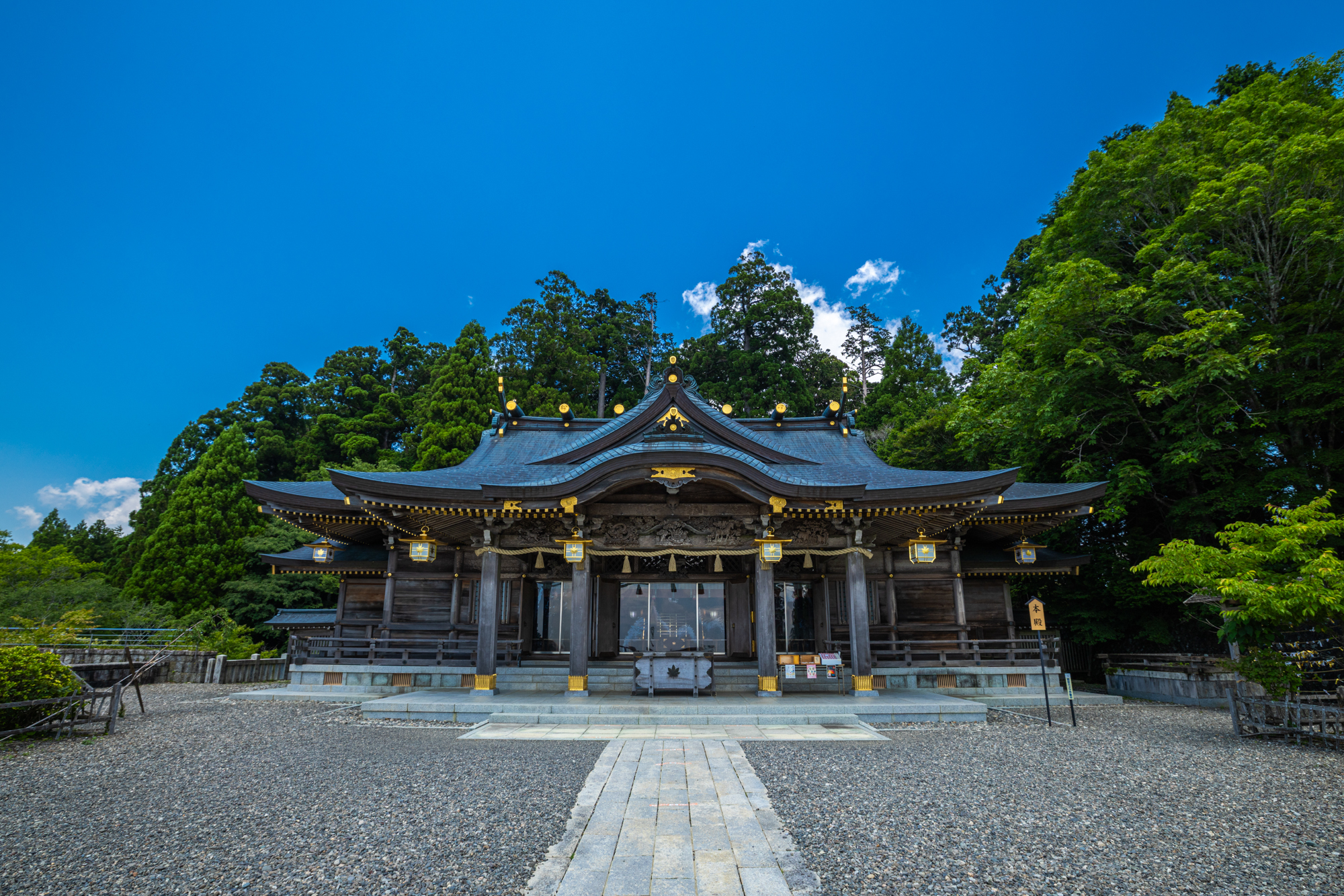
Akiha Shrine Main Hall
The sacred object of Akiha Shrine was relocated to the foothills of Mount Akiba following a wildfire in 1943.
That relocated site is the current Lower Shrine.
Decades later, the main hall was rebuilt in 1986.
Standing with the sacred grounds of Mount Akiha behind it, the main hall exudes a serene yet dignified presence.
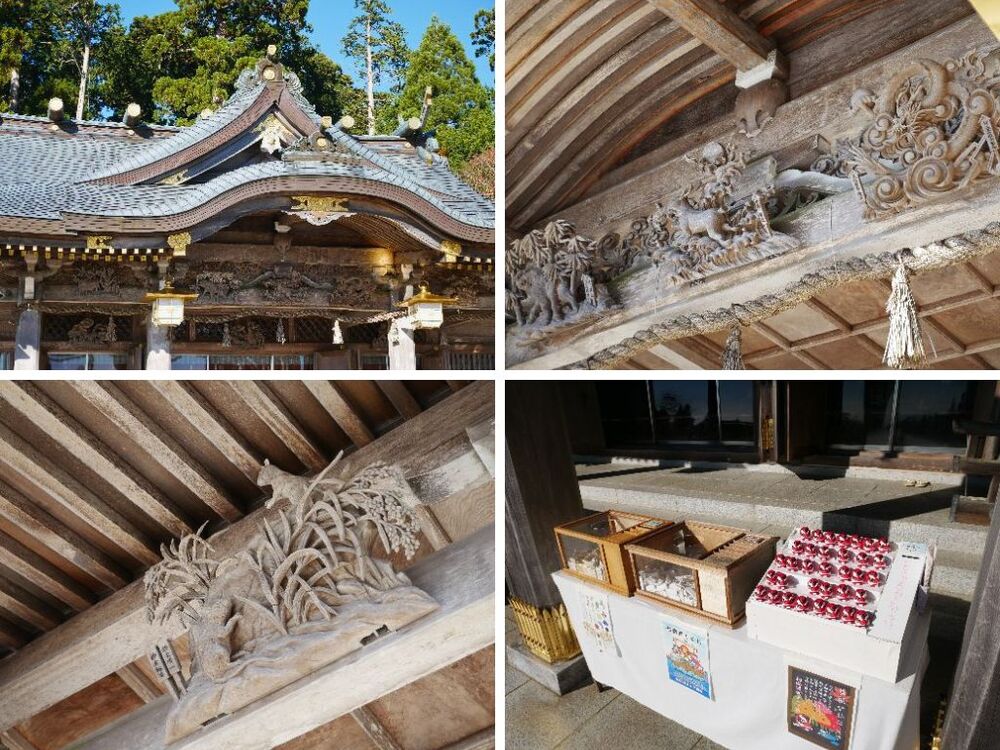
Top left: Main hall of Akiha Shrine, Top right: Zodiac carvings above the offertory box, Bottom left: Zodiac carvings above the offertory box, Bottom right: From left, Gold-colored Omikuji, Seven Lucky Gods Omikuji, Tengu Omikuji
On the left side of the offertory box, you’ll find several types of omikuji (fortune slips).
Among them, the Tengu-sama Omikuji stands out, inspired by the tengu said to have once dwelled on Mount Akiha.
After drawing your fortune slip, be sure to check out the charms for good luck and protection from misfortune.
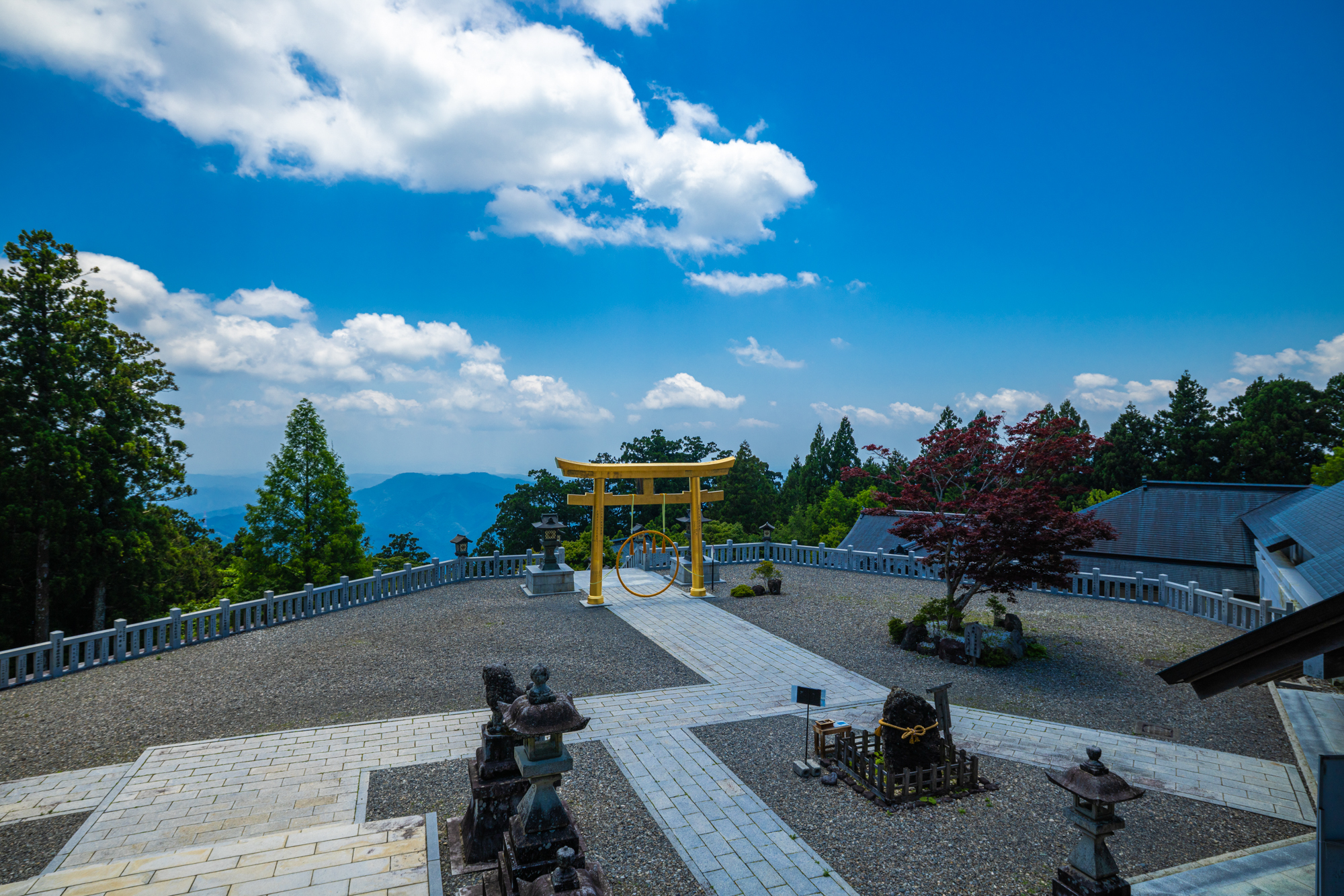
The main hall of Akiha Shrine sits on a higher ground beyond the Torii of Happiness, offering an exceptional panoramic view!
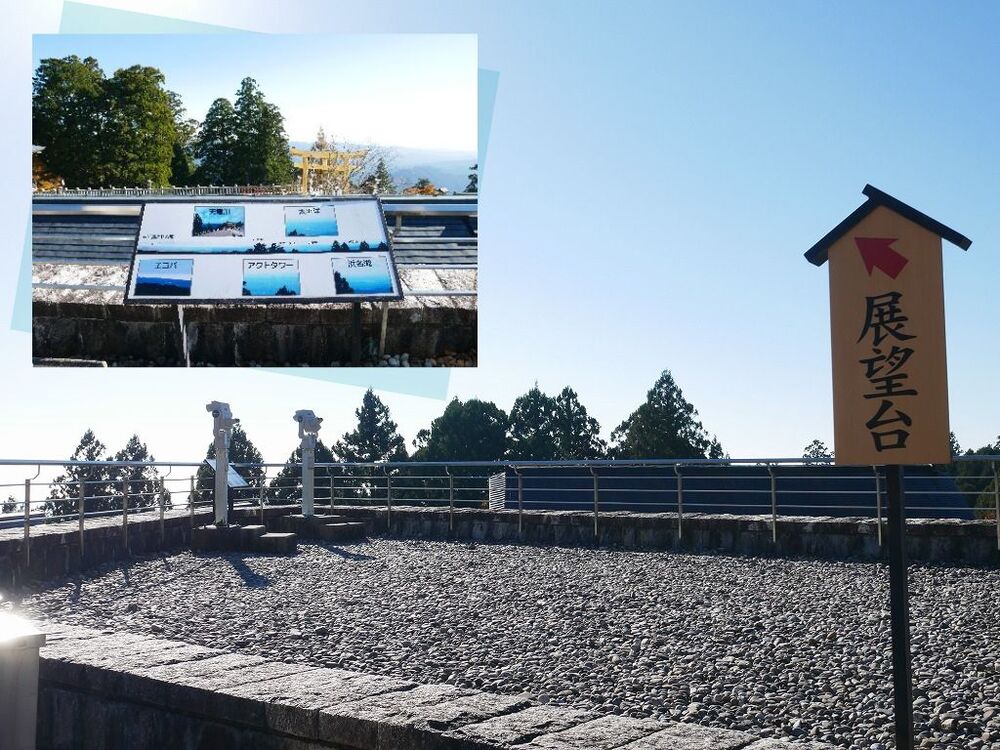
View from the observation deck(Left top) and The observation deck
From the observation deck, you can see the Tenryu River flowing through the city, the Act Tower near JR Hamamatsu Station, and even Ecopa Stadium in Fukuroi City.
You can also see the Pacific Ocean and Lake Hamana in the distance!
The restored sacred gate now stands on the main approach.
As mentioned earlier, there are sacred gates on both the east and west sides of the Akiha Shrine approach.
The eastern approach is the main path connecting from the Lower Shrine, and its gate stands about 180 meters downhill from the shrine office.
Walking down the approach, the sacred gate gradually comes into view through the towering cedar trees.
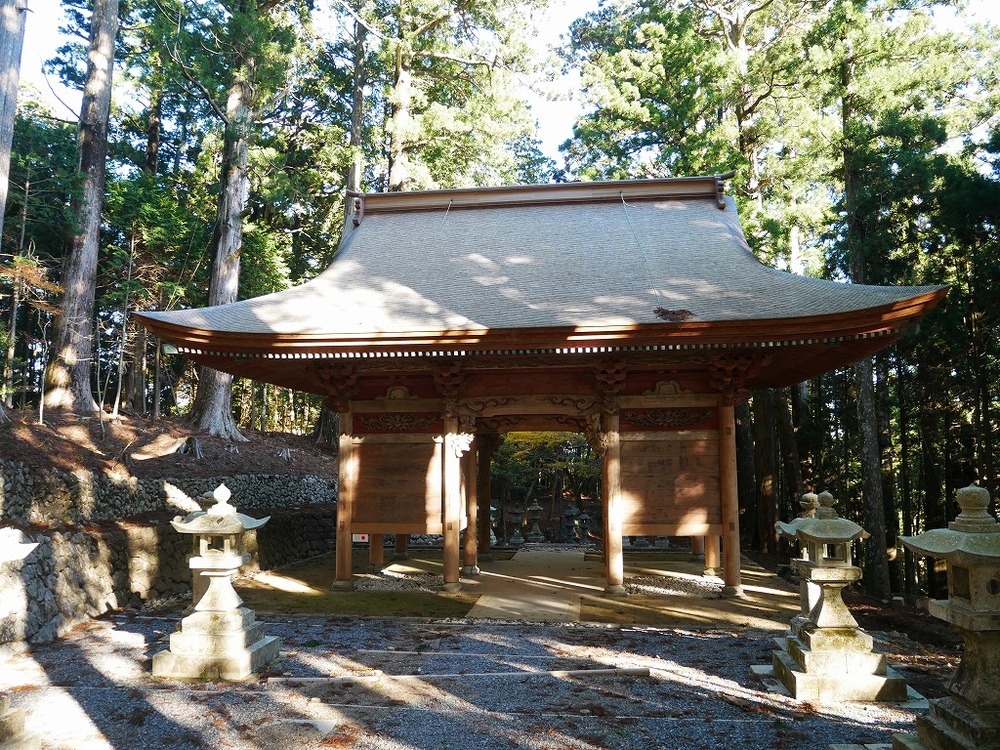
Sacred Gate as seen from the main hall side
In October 2018, Typhoon No. 24, a powerful storm that caused extensive damage in the Enshu region, toppled a giant cedar tree that crashed onto the roof of Akiha Shrine’s sacred gate, severely damaging it.
After careful discussions and consideration, it was decided to fully dismantle and repair the sacred gate.
The termite damage on the pillars and carvings was carefully filled with wood inserts, and missing parts were restored using the same type of wood as the original.
The gate was faithfully rebuilt to its appearance from the Tenpō era.
In May 2023, it was revived to its former glory.
From the shrine side, the gate has a simple, understated look like this.
Now, let’s pass through the gate and take a closer look.
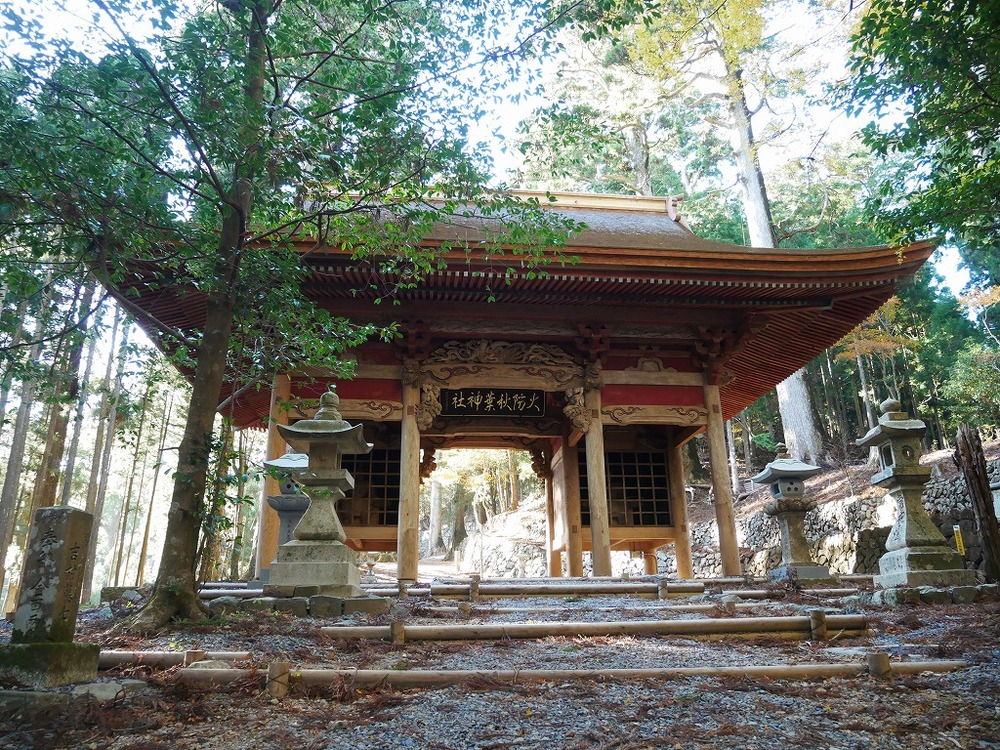
Sacred Gate viewed from the bottom of the stairs on the approach path side (Lower Shrine side).
On the Lower Shrine (Omotesando) side, the gate features intricate carvings on the beams and sides.
At its center hangs a wooden plaque inscribed with “Fire Prevention Akiha Shrine.”
Visitors walking from the Lower Shrine toward the Upper Shrine would catch sight of the gate framed by towering cedar trees, gradually drawing nearer with each step.
One wonders what thoughts filled their hearts as they approached this sacred gateway.
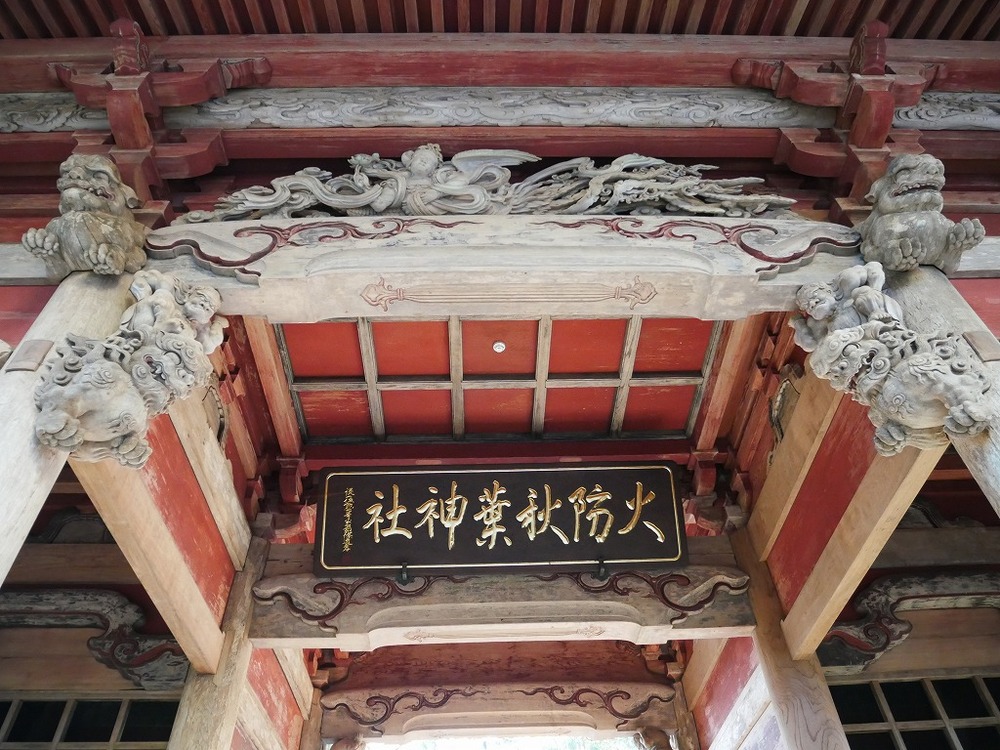
The Karyobinga gracefully dancing atop the beam is carved from a single piece of cypress wood.
Looking straight up at the gate from below, you’ll see a power figure standing atop a shishi lion, and above the beam supported by this figure, a graceful Karyobinga bird.
On either side of the beam are carved tigers.
The Karyobinga is a mythical creature with the upper body of a celestial maiden and the lower body of a phoenix.
It is said to have a beautiful voice and is also known as the “Myooncho,” or “Bird of Wonderful Sound.”
The distance from the Shrine Gate to the Lower Shrine is about 4 kilometers.
Visitors who reached the Akiha Shrine Gate might have taken a moment to catch their breath and look back along the path they came from.
If walking the 4 kilometers from the Lower Shrine to see the Shrine Gate feels a bit much, why not try heading down the approach from the Upper Shrine, like I did?
A Closer Look at Akiba Shrine’s Omamori Charms
After visiting the shrine, don’t you want to check out the charms and fortune slips?
Because Akiha Sanshakubō, who has a deep connection with Akiha Shrine, is known as the leader of the Tōtōmi Tengu, you’ll also find charms and decorative hamayumi arrows featuring tengu designs.
You’ll find a wide variety of charms and lucky items on display, neatly arranged for you to browse through.
The Kōun Mamori (Nishiki Charm), featuring the beautifully designed seven-leaf maple crest, is rich in color and detail.
Other popular items include the Hiuchi-ishi Harai Mamori (fire striker purification charm) and traffic safety stickers.
As a side note, I received this charm myself.
We’ve introduced Akiha Shrine, the head shrine of Mount Akiha.
It’s a place where you can forget the hustle and bustle of the city and find a moment to reflect quietly within the shrine’s peaceful atmosphere.
Here, nature and history blend harmoniously, offering visitors both healing and renewed energy.
We warmly invite you to visit this special place, Akiha Shrine.
 ̄ ̄ ̄ ̄ ̄ ̄ ̄ ̄ ̄ ̄ ̄
Official Website of Akiha Shrine: https://www.akihasanhongu.jp/index.html
We have prepared a special video for you this time, so please enjoy it along with the article.
We hope it brings the charm of Akiha Shrine even closer to you.
Panoramic View of Akihasan Hongu Akiha Shrine
Akiha Fire Festival
Tezutsu Fireworks Dedication Festival
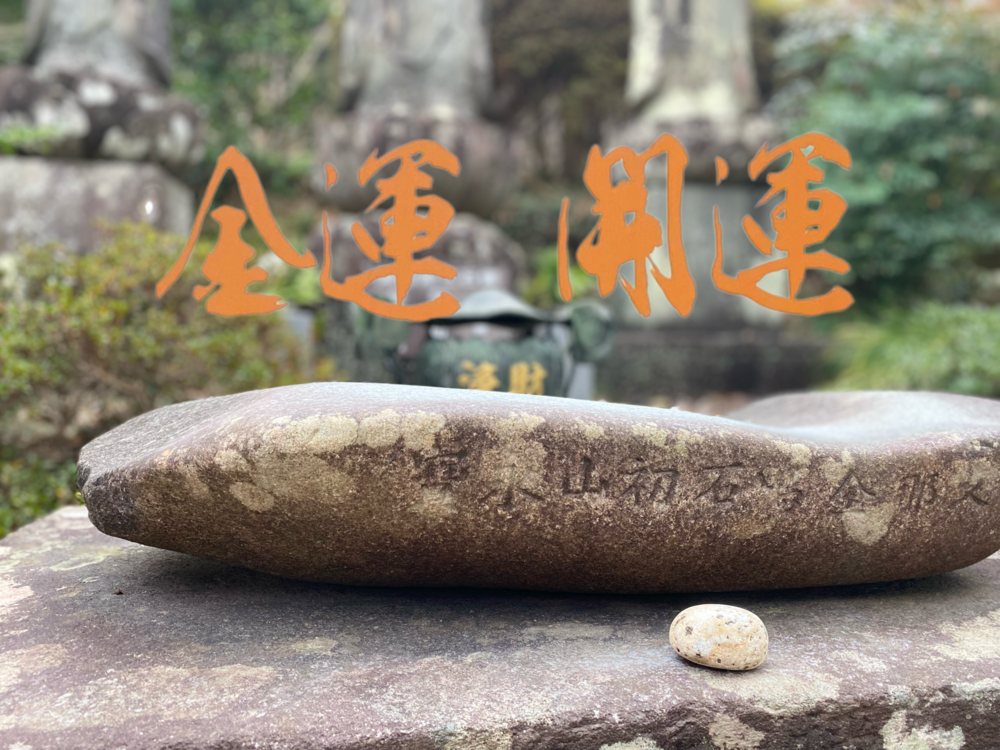
Don’t Miss Out! Hamamatsu’s Ultimate Lucky Money Spot ♡ Shosan Hōrinji — Take Home an Original Good Luck Charm!
